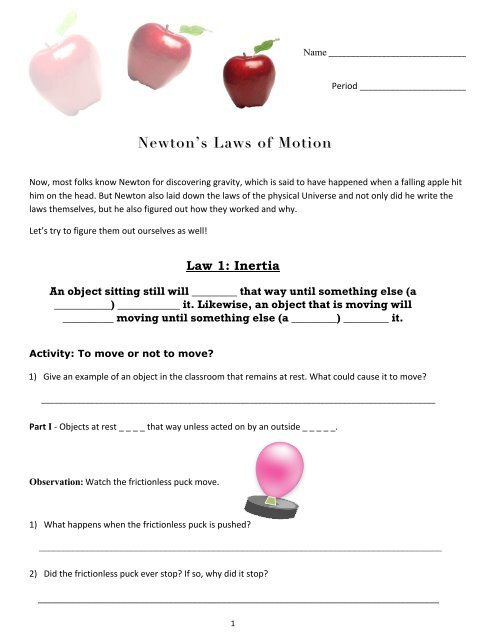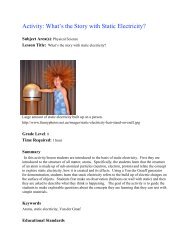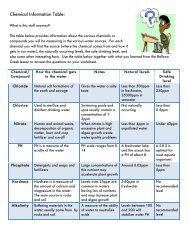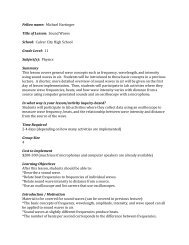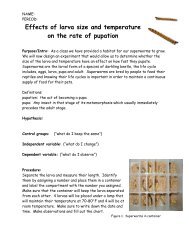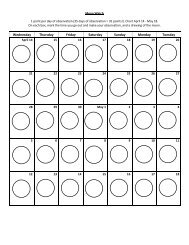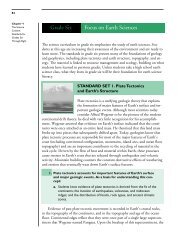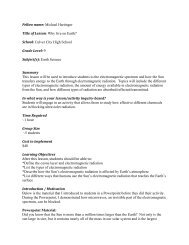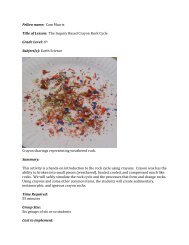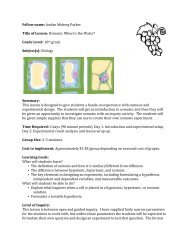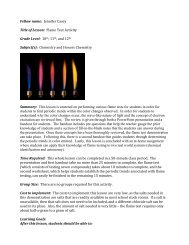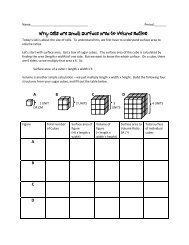Newton's Laws of Motion Newton's Laws of Motion
Newton's Laws of Motion Newton's Laws of Motion
Newton's Laws of Motion Newton's Laws of Motion
You also want an ePaper? Increase the reach of your titles
YUMPU automatically turns print PDFs into web optimized ePapers that Google loves.
<br />
<br />
<br />
<br />
Newton’s <strong>Laws</strong> <strong>of</strong> <strong>Motion</strong><br />
1 <br />
Name _______________________________ <br />
Period ________________________ <br />
Now, most folks know Newton for discovering gravity, which is said to have happened when a falling apple hit <br />
him on the head. But Newton also laid down the laws <strong>of</strong> the physical Universe and not only did he write the <br />
laws themselves, but he also figured out how they worked and why. <br />
Let’s try to figure them out ourselves as well! <br />
Law 1: Inertia<br />
An object sitting still will ________ that way until something else (a<br />
__________) ___________ it. Likewise, an object that is moving will<br />
_________ moving until something else (a ________) ________ it.<br />
<br />
Activity: To move or not to move?<br />
1) Give an example <strong>of</strong> an object in the classroom that remains at rest. What could cause it to move? <br />
_________________________________________________________________________________________ <br />
Part I ‐ Objects at rest _ _ _ _ that way unless acted on by an outside _ _ _ _ _.<br />
Observation: Watch the frictionless puck move.<br />
1) What happens when the frictionless puck is pushed? <br />
___________________________________________________________________________________<br />
2) Did the frictionless puck ever stop? If so, why did it stop? <br />
___________________________________________________________________________________
<br />
<br />
<br />
<br />
<br />
<br />
<br />
3) Explain how the frictionless puck could go on forever if there was nothing blocking its path. This is the <br />
same reason spaceships can sail through space forever in one direction without ever stopping! <br />
___________________________________________________________________________________ <br />
___________________________________________________________________________________ <br />
Part II – Objects in motion _ _ _ _ that way unless acted on by an outside _ _ _ _ _. <br />
<br />
Conclusion <br />
That's what you call Inertia! <br />
If you're hanging out on the couch watching TV, you're probably not likely to budge, nor will <br />
the TV, unless something like a bulldozer or an earthquake (outside forces) makes you move. <br />
<br />
Likewise, if you're catching a wave or coasting downhill, you're <br />
going to keep on going until the wave crashes (an outside force) or <br />
you crash into an obstacle, like maybe a rock or wall (an outside force). <br />
<br />
<br />
What’s this got to do with me? <br />
Newton’s first law can be seen all around us. You can use the law to figure out simple things like if an egg is <br />
cooked or raw. It can also help explain things that happen to us every day, like what happens during a car <br />
crash. <br />
Observation: Watch the car safety video. <br />
1) What happened when the car crashed into the wall? <br />
__________________________________________________________________________________ <br />
2) Why should people wear seatbelts while in the car? (use Newton’s 1 st law to explain) <br />
__________________________________________________________________________________ <br />
<br />
2
<br />
<br />
<br />
Activity: Now try the same idea with the penny on an index card. Who can get the most pennies in the cup <br />
without picking up or grabbing the index card? <br />
<br />
<br />
<br />
<br />
<br />
<br />
<br />
<br />
Hypothesize and Experiment Come up with your own way <strong>of</strong> getting the penny into the cup without <br />
picking up or grabbing the index card. Best methods will compete for a prize! <br />
1) What was your method for getting the penny into the cup? Explain how it worked using Newton’s first law. <br />
<br />
<br />
<br />
_________________________________________________________________________________ <br />
_________________________________________________________________________________ <br />
_________________________________________________________________________________ <br />
Law 2: =<br />
The amount <strong>of</strong> ________ something has depends on how big it<br />
is (______) and how fast it is ________ (__________).<br />
Hypothesis: What will happen when a heavy ball hits a light ball? What will happen when a light ball hits a <br />
heavy ball? <br />
1) What happens when the two balls hit each other? Explain what happened to the smaller ball using force, <br />
mass, and acceleration. <br />
__________________________________________________________________________________ <br />
__________________________________________________________________________________ <br />
<br />
<br />
3 <br />
x <br />
?
<br />
<br />
<br />
<br />
<br />
<br />
<br />
Newton in Sports <br />
Just standing there, a pro basketball player is not exhibiting much force. Sure he's huge, lots <strong>of</strong> mass, but he <br />
isn’t moving ‐ no acceleration. But have this same basketball player run at you at full speed and what do you <br />
think will happen? <br />
<br />
<br />
<br />
<br />
<br />
<br />
Conclusion <br />
Fill in the blanks using your observations from the ball collisions and when two basketball players run into <br />
each other. <br />
1) Now suppose we have two football players. One is very strong and has been playing for a long time. The <br />
other one is smaller and hasn’t been playing long, but really wants to help his team win. If these two are <br />
running toward each other and want to make a tackle (the force is the tackle) what will the smaller <br />
football player have to have more <strong>of</strong> than the big guy in order to make the tackle? Yes, speed or <br />
acceleration! <br />
<br />
<br />
Hey Coach! <br />
2) Let’s say you’re the football coach for the smaller player. How much acceleration do you need your player <br />
to have to stop the larger player? The larger player has a mass <strong>of</strong> 136 kg and an acceleration <strong>of</strong> 0.5 m/s 2 . <br />
The smaller player has a mass <strong>of</strong> 108 kg. (Remember, forces must be balanced!) <br />
<br />
No force <br />
4 <br />
Still vs. Charging <br />
Answer = <br />
Large force
<br />
<br />
<br />
What’s this got to do with me? <br />
Now use your new Newton skills to try and hit all the targets. Keep in mind the force and acceleration you’ll <br />
need to achieve to get the marshmallow to the right distance. <br />
<br />
Activity: Marshmallow Puff Gun <br />
1) What did you try to get the marshmallow to hit the first target? Draw the marshmallow’s first position in <br />
the tube. <br />
__________________________________________________ <br />
2) Explain why the marshmallow flew farther in the second position? Draw the marshmallow’s second <br />
position in the tube. (Use Newton’s 2 nd law to explain) <br />
__________________________________________________ <br />
__________________________________________________ <br />
_________________________________________________________________________________ <br />
3) What did you have to do to get the marshmallow to the last target? Draw the marshmallow’s final position <br />
in the tube. <br />
<br />
______________________________________________ <br />
______________________________________________ <br />
________________________________________________________________________________ <br />
Can you hit the targets? <br />
Hypothesis Fill in the chart below with what you tried to hit the targets that are 2, 4, and 6 meters away. <br />
<br />
Target Distance Force needed (S, M, L) <br />
F = m x a, must be balanced! <br />
Mass (Change/No Change) Acceleration (S, M, L) <br />
2 m <br />
<br />
<br />
<br />
4 m <br />
<br />
<br />
<br />
6 m <br />
<br />
<br />
<br />
5
<br />
4) What worked in your strategy? (use Newton’s 2 nd law to explain) <br />
________________________________________________________________________________ <br />
<br />
<br />
<br />
<br />
________________________________________________________________________________ <br />
________________________________________________________________________________ <br />
<br />
6 <br />
Let’s wrap it up! <br />
<br />
That’s it! Newton’s three laws may seem complicated at first but they are real simple once you see them used <br />
all around you. Let’s review. <br />
<br />
<br />
<br />
<br />
<br />
<br />
<br />
<br />
<br />
<br />
<br />
<br />
<br />
<br />
<br />
<br />
<br />
<br />
<br />
<br />
<br />
<br />
<br />
1. Objects in motion (or at rest) stay that way unless acted on by an<br />
outside force.<br />
2. Force equals mass times acceleration, or F=ma.<br />
3. For every action there is an equal and opposite reaction.<br />
1. Honeywell International Inc. Copyright 2009 and NASA <br />
2. Exploratorium: Science Snacks


